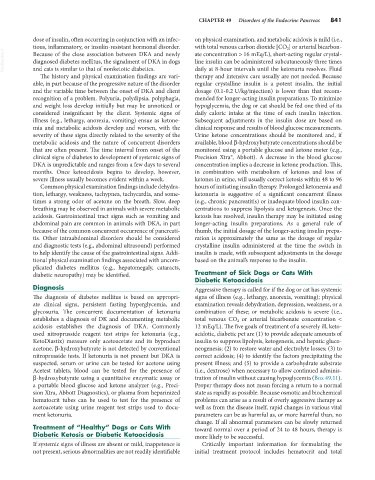Page 869 - Small Animal Internal Medicine, 6th Edition
P. 869
CHAPTER 49 Disorders of the Endocrine Pancreas 841
dose of insulin, often occurring in conjunction with an infec- on physical examination, and metabolic acidosis is mild (i.e.,
tious, inflammatory, or insulin-resistant hormonal disorder. with total venous carbon dioxide [CO 2 ] or arterial bicarbon-
VetBooks.ir Because of the close association between DKA and newly ate concentration > 16 mEq/L), short-acting regular crystal-
line insulin can be administered subcutaneously three times
diagnosed diabetes mellitus, the signalment of DKA in dogs
and cats is similar to that of nonketotic diabetics.
therapy and intensive care usually are not needed. Because
The history and physical examination findings are vari- daily at 8-hour intervals until the ketonuria resolves. Fluid
able, in part because of the progressive nature of the disorder regular crystalline insulin is a potent insulin, the initial
and the variable time between the onset of DKA and client dosage (0.1-0.2 U/kg/injection) is lower than that recom-
recognition of a problem. Polyuria, polydipsia, polyphagia, mended for longer-acting insulin preparations. To minimize
and weight loss develop initially but may be unnoticed or hypoglycemia, the dog or cat should be fed one third of its
considered insignificant by the client. Systemic signs of daily caloric intake at the time of each insulin injection.
illness (e.g., lethargy, anorexia, vomiting) ensue as ketone- Subsequent adjustments in the insulin dose are based on
mia and metabolic acidosis develop and worsen, with the clinical response and results of blood glucose measurements.
severity of these signs directly related to the severity of the Urine ketone concentrations should be monitored and, if
metabolic acidosis and the nature of concurrent disorders available, blood β-hydroxybutyrate concentrations should be
that are often present. The time interval from onset of the monitored using a portable glucose and ketone meter (e.g.,
clinical signs of diabetes to development of systemic signs of Precision Xtra®, Abbott). A decrease in the blood glucose
DKA is unpredictable and ranges from a few days to several concentration implies a decrease in ketone production. This,
months. Once ketoacidosis begins to develop, however, in combination with metabolism of ketones and loss of
severe illness usually becomes evident within a week. ketones in urine, will usually correct ketosis within 48 to 96
Common physical examination findings include dehydra- hours of initiating insulin therapy. Prolonged ketonemia and
tion, lethargy, weakness, tachypnea, tachycardia, and some- ketonuria is suggestive of a significant concurrent illness
times a strong odor of acetone on the breath. Slow, deep (e.g., chronic pancreatitis) or inadequate blood insulin con-
breathing may be observed in animals with severe metabolic centrations to suppress lipolysis and ketogenesis. Once the
acidosis. Gastrointestinal tract signs such as vomiting and ketosis has resolved, insulin therapy may be initiated using
abdominal pain are common in animals with DKA, in part longer-acting insulin preparations. As a general rule of
because of the common concurrent occurrence of pancreati- thumb, the initial dosage of the longer-acting insulin prepa-
tis. Other intraabdominal disorders should be considered ration is approximately the same as the dosage of regular
and diagnostic tests (e.g., abdominal ultrasound) performed crystalline insulin administered at the time the switch in
to help identify the cause of the gastrointestinal signs. Addi- insulin is made, with subsequent adjustments in the dosage
tional physical examination findings associated with uncom- based on the animal’s response to the insulin.
plicated diabetes mellitus (e.g., hepatomegaly, cataracts,
diabetic neuropathy) may be identified. Treatment of Sick Dogs or Cats With
Diabetic Ketoacidosis
Diagnosis Aggressive therapy is called for if the dog or cat has systemic
The diagnosis of diabetes mellitus is based on appropri- signs of illness (e.g., lethargy, anorexia, vomiting); physical
ate clinical signs, persistent fasting hyperglycemia, and examination reveals dehydration, depression, weakness, or a
glycosuria. The concurrent documentation of ketonuria combination of these; or metabolic acidosis is severe (i.e.,
establishes a diagnosis of DK and documenting metabolic total venous CO 2 or arterial bicarbonate concentration <
acidosis establishes the diagnosis of DKA. Commonly 12 mEq/L). The five goals of treatment of a severely ill, keto-
used nitroprusside reagent test strips for ketonuria (e.g., acidotic, diabetic pet are (1) to provide adequate amounts of
KetoDiastix) measure only acetoacetate and its byproduct insulin to suppress lipolysis, ketogenesis, and hepatic gluco-
acetone. β-hydroxybutyrate is not detected by conventional neogenesis; (2) to restore water and electrolyte losses; (3) to
nitroprusside tests. If ketonuria is not present but DKA is correct acidosis; (4) to identify the factors precipitating the
suspected, serum or urine can be tested for acetone using present illness; and (5) to provide a carbohydrate substrate
Acetest tablets, blood can be tested for the presence of (i.e., dextrose) when necessary to allow continued adminis-
β-hydroxybutyrate using a quantitative enzymatic assay or tration of insulin without causing hypoglycemia (Box 49.11).
a portable blood glucose and ketone analyzer (e.g., Preci- Proper therapy does not mean forcing a return to a normal
sion Xtra, Abbott Diagnostics), or plasma from heparinized state as rapidly as possible. Because osmotic and biochemical
hematocrit tubes can be used to test for the presence of problems can arise as a result of overly aggressive therapy as
acetoacetate using urine reagent test strips used to docu- well as from the disease itself, rapid changes in various vital
ment ketonuria. parameters can be as harmful as, or more harmful than, no
change. If all abnormal parameters can be slowly returned
Treatment of “Healthy” Dogs or Cats With toward normal over a period of 24 to 48 hours, therapy is
Diabetic Ketosis or Diabetic Ketoacidosis more likely to be successful.
If systemic signs of illness are absent or mild, inappetence is Critically important information for formulating the
not present, serious abnormalities are not readily identifiable initial treatment protocol includes hematocrit and total

